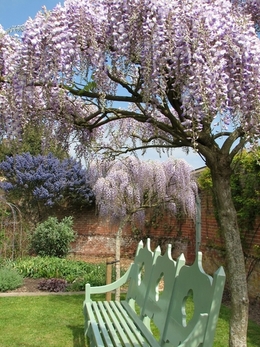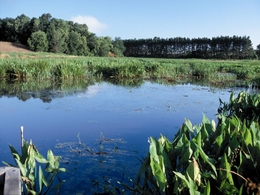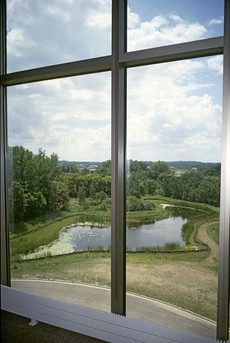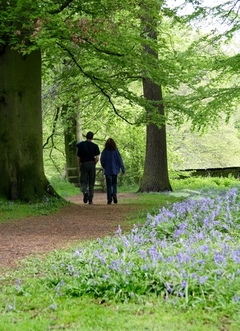What Are Healing Gardens?

 Why are some gardens called healing gardens, when it seems as though all gardens (and nature) are intrinsically appealing and beneficial to humans?
Why are some gardens called healing gardens, when it seems as though all gardens (and nature) are intrinsically appealing and beneficial to humans?
The term healing gardens is most often applied to green spaces in hospitals and other healthcare facilities that specifically aim to improve health outcomes. These gardens provide a place of refuge and promote healing in patients, families, and staff. Any environment can promote healing, but gardens are particularly able to do so because humans are hard-wired to find nature engrossing and soothing.
According to two leaders in this field, Clare Cooper Marcus and Marni Barnes, healing comes because the gardens promote:
- Relief from symptoms
- Stress reduction
- Improvement in overall sense of wellbeing and hopefulness
Healing gardens differ somewhat from therapeutic landscapes, which is another term used in healthcare. Therapeutic landscapes or gardens are designed to meet the particular needs of a specific patient population. They often engage that population actively and deliberately. Healing gardens, on the other hand, generally aim for a more passive involvement and are designed to provide benefits to a diverse population with different needs.
Why is nature still important to humans?
 Regardless of age or culture, humans find nature restorative. In one study, researchers Marcus and Barnes found that more than two-thirds of people choose a natural setting to retreat to when stressed. In another study, 95% of those interviewed said their mood improved after spending time outside, changing from depressed, stressed, and anxious to more calm and balanced.
Regardless of age or culture, humans find nature restorative. In one study, researchers Marcus and Barnes found that more than two-thirds of people choose a natural setting to retreat to when stressed. In another study, 95% of those interviewed said their mood improved after spending time outside, changing from depressed, stressed, and anxious to more calm and balanced.
Why do we find nature so restorative? One school of thought holds that it is hardwired in our genes. Roger Ulrich, a leading researcher in healing gardens, summarizes it thus: "We have a kind of biologically prepared disposition to respond favorably to nature because we evolved in nature. Nature was good to us, and we tend to respond positively to environments that were favorable to us."
Another reason for our biological connection to nature could be that humans who paid close attention to nature gathered key information that helped them survive and reproduce. So the tendency to find nature engrossing lived on in those genes.
Many studies show that after a stressful event, images of nature very quickly produce a calming effect. Within three to four minutes after viewing nature scenes, blood pressure, respiration rate, brain activity, and the production of stress hormones all decrease and mood improves. This again has an evolutionary advantage because it allows us to recuperate and recover our energy quickly. This ability to recover from stress quickly in order to be ready to respond to new threats was important for our ancestors' survival.
Nature is also fundamentally linked to our human spirituality. Out in nature, we feel how we are connected to entities beyond ourselves and understand our interdependencies with other living beings. Nature also prompts us to reflect on the ever-changing nature of existence and what might lie beyond it. Nature provides a space in which we can connect spiritually both with ourselves and outside ourselves.
What health benefits does viewing nature offer?
- Nature provides a great distraction. Because we are genetically programmed to find nature engrossing, we are absorbed by nature scenes and distracted from our pain and discomfort.
- Nature reduces stress and anxiety. One explanation for this is that nature provides a respite from the constant effort to screen out competing stimuli in our busy lives. Because humans find nature inherently engrossing, we don't have to make an effort to focus when presented with natural views. This reduces mental fatigue and refreshes the mind.
- Plants offer psychological comfort. As one researcher in this area, Lewis, says "Plants take away some of the anxiety and tension of the immediate now by showing us that there are long, enduring patterns in life." Their growth is steady and progressive, not erratic.
While there are various theories why nature is so helpful, there is no variance on the outcomes. We know that viewing plants, flowers, water, and other nature elements reduces patient anxiety, even if the patients are very anxious.
Supporting Research
 The benefits of nature hold even for confirmed city dwellers. In a study of cardiac patients in New York who were shown various scenes, anxiety was reduced the most in those who saw a nature scene and heard a sound track of water, birds, and breezes.
The benefits of nature hold even for confirmed city dwellers. In a study of cardiac patients in New York who were shown various scenes, anxiety was reduced the most in those who saw a nature scene and heard a sound track of water, birds, and breezes.
In addition to the psychological benefits, reducing patient stress and anxiety has concrete physical benefits. This is nicely demonstrated in a study of patients who underwent gallbladder surgery; half had a view of nature and half had a view of a wall. The half with the nature view tolerated pain better, slept better, reported less stress, and spent less time in a hospital.
Thus, it is no wonder that the Center for Health Design identifies nature as one of the key factors that reduces patient and staff stress and leads to better outcomes and staff satisfaction.
In addition, the Joint Commission for Accreditation of Hospitals (JCAHO) recommends that "Patients and visitors should have opportunities to connect with nature through outside spaces, plants, indoor atriums and views from windows."
Of course nature can benefit everyone, not just those in hospitals. One fascinating study reported that tenants in Chicago public housing who had trees around their buildings reported knowing more people, having stronger feelings of unity with neighbors, beoming more concerned with helping and supporting each other, and having stronger feelings of belonging than tenants in buildings without trees. The findings also showed less violence in buildings with tress than in those without trees.
 Gardens provide psychological, social, physical, emotional, and spiritual benefits to humans. A large part of this is because of the positive reactions humans have to nature, so it is important for healing gardens to have lots of green vegetation, flowers, and water elements.
Gardens provide psychological, social, physical, emotional, and spiritual benefits to humans. A large part of this is because of the positive reactions humans have to nature, so it is important for healing gardens to have lots of green vegetation, flowers, and water elements.
This is important because, apart from the physical benefits, even mild exercise elevates mood. Gardens offer a desired destination that prompts people to walk there and motivate people to explore once there.
Gardens offer a break from the hospital environment and provide a variety of pleasant things to look at and listen to. Humans naturally find nature interesting, so find it easy to be engaged in a garden with the variety of colors, textures, light, and sound.
For many people, being in nature and interacting with the natural world, brings a sense of peace, tranquility, and feelings of connectedness - with self, others and a higher power.
Social support enhances immune functions, promotes better moods, and produces better treatment compliance. Gardens can encourage this interaction if they are easily accessible to patients, families, and staff and offer groupings of lightweight, moveable chairs.
We all need to feel that we have choices about what we can do, but hospital effectively removes much of that: we give up control over what we wear, when we can eat and sleep, and our privacy. People in hospital are generally physically less capable and their normal life, work, and social support is disrupted. Gardens can enhance a sense of control if they offer a variety of spaces to choose from-some private and some open, some sunny, some shady, some with background sounds, some without, and so forth.
Gardens reduce stress and promote a sense of wellbeing. This leads to measurable psychological, physiological, and behavioral benefits, such as reduced anxiety, sadness, and other negative moods, lower blood pressure and improved immune functioning, and better compliance with treatment protocol.
- 1 of 7
- 2 of 7
- 3 of 7
- 4 of 7
- 5 of 7
- 6 of 7
- 7 of 7
What are important features of healing gardens?
 The most important feature in a healing garden is real nature-green vegetation, flowers, and perhaps a calm water element. A garden full of sculptures and structures will not offer the healing benefits of nature.
The most important feature in a healing garden is real nature-green vegetation, flowers, and perhaps a calm water element. A garden full of sculptures and structures will not offer the healing benefits of nature.
It is particularly important to avoid abstract art and sculpture, which ill people often interpret in negative ways. For example, patients thought that a large gazing ball in one garden was the "evil eye." A somewhat abstracted sculptures of birds was seen as "vultures that scrape flesh."
Healing gardens should also be situated where sounds of the city or loud mechanical noises (such as an air conditioning unit) don't intrude. And the outdoor smoking area should be located far away from the garden!
What about the benefits of gardening?
All the benefits of viewing a garden are also present when you are gardening. In addition, engaging in gardening is a great physical activity.
Gardening can also enhance self-esteem, because plants respond to care regardless of who gives it and are non-threatening and non-discriminating. Plants can give elderly or other patients who have no family something to care for.
As experiences in New York and Philadelphia demonstrate, gardening can transcend severe social problems to create a sense of community. In one fascinating example, inhabitants of public housing in New York experienced more neighborly connection, reduced vandalism, and increased cleanliness when the housing authority initiated a gardening contest.


